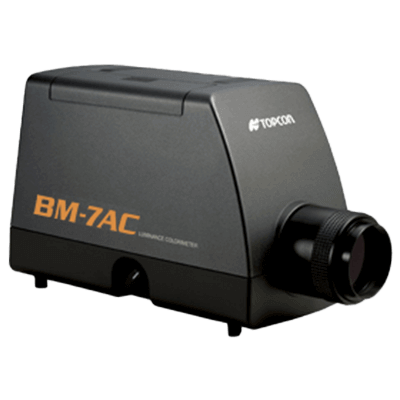What Is a Luminance Color Meter?

A luminance color meter can measure the average luminance and chromaticity per area of a luminous surface (such as a computer display) or a reflective surface (a surface of a material that does not emit light itself). Luminance represents the brightness per unit area of a luminous surface, and chromaticity represents the color quantified by a function called the color system. Chromaticity values are expressed in terms of color coordinates (x, y) and luminance Y (cd/m2). Because it is non-contact and compact, it is used in many quality control applications and as a sensor, and it is used to evaluate retro reflectance (reflection of light back in the direction of irradiation) and to evaluate the performance of safety signs.
Applications of Luminance Color Meters
Luminance color meters can be used to measure computer displays, cell phone and camera displays, lamp and fluorescent tube light sources, large outdoor vision displays, painted building surfaces, automobile lamps, and traffic signals. Quality control of industrial products, measurement of chromaticity, color difference, and color irregularity can be performed.
Because some computer and TV displays emit light repeatedly with short periods that are not visible, the chromaticity of broadcast images can be measured with a luminance color meter, which can measure both luminance and chromaticity. This cannot be measured with a spectrophotometer. The device is also small and portable, so it can be used for landscape assessment and landscape management because it can measure the influence of luminance on chromaticity, weather, and weather on the landscape.
Features of the Luminance Color Meters
The chromaticity stimulus used in the luminance color meter is a value that provides three stimulus values (XYZ = red, green, and blue) of color. These tri-stimulus values are almost identical to the wavelengths of the three types of cone cells in the human retina that perceive color and light, and thus can objectively quantify perception. These three types of cone cells include S-cones, which perceive short wavelengths of blue, M-cones, which perceive medium wavelengths of green, and L-cones, which perceive long wavelengths of red. Luminance is a numerical value that expresses brightness, and Y=1 or Y=100 (because the unit of tristimulus value is arbitrary) is considered being the brightest white that can be expressed on a color display.
A luminance color meter has sensors corresponding to wavelengths in the visible light range lined up in the internal measuring section. In the spectral fitting method, 40 sensors are lined up from 380 nm to 780 nm, while the spectral type measurement method requires 401 sensors in the same visible light range. The new method, which used to be a Julia spectral type, is now a spectral-fitting type, and the number of sensors can be reduced to less than one-tenth of the original number. Light incident on the sensors is reacted by each sensor, and three waveforms (XYZ) are calculated as a composite function. XYZ values are calculated from the derived waveforms.